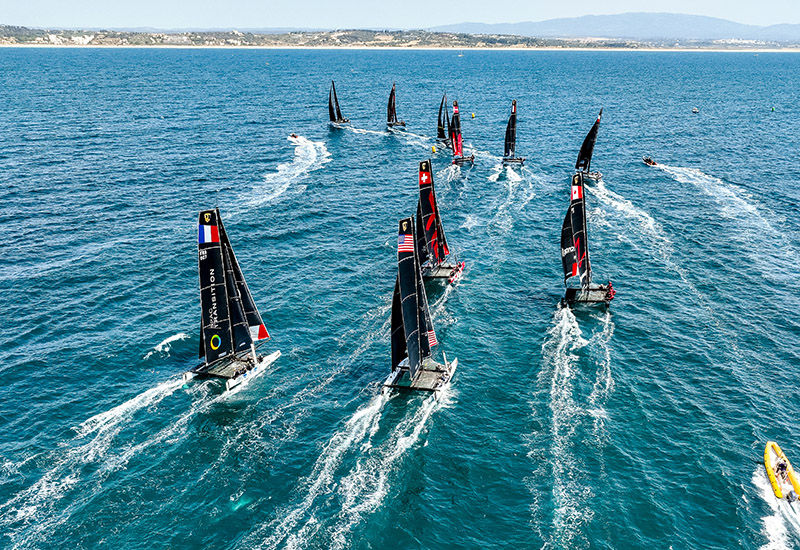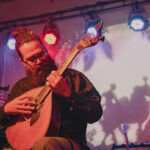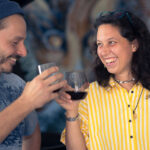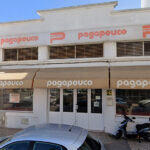The GC32 World Championships Returned to Lagos from 14 – 17 July
Photography GC32 Racing Tour / Sailing Energy
I was privileged to be invited onto one of the press boats to view the fourth GC32 World Championships. Held in Lagos Bay, I got a close-up look at these magnificent catamarans and the chance to speak to the organisers and teams.
It was a truly magnificent sporting spectacle. Ten-metre-long vessels flying through the water on foils that elevate them above the waves. The crews balanced precariously on their carbon fibre hulls, using all their skills to catch every breath of wind in their towering black sails, embossed with their sponsors and flags of their country of origin. The GC32 catamaran was conceived by Laurent Lenne and designed by Dr Martin Fischer, now Chief Designer for the British INEOS Britannia America’s Cup Challenger.
I was on board a press boat with the event’s official photographer, Jesus Renedo. We were bobbing on the very edges of the course, from where we could hear the clanging of the rigging as the boats were tacked around the buoys that marked the end of the course. The roar of the wind in the sails and the agility of the crew scrambling from one side to the other to pull the sheets were something to behold.

The GC32 catamaran features a soft-sail rig with no hydraulics. It is fitted with T-foil rudders and J-shaped daggerboards/foils, conceptually similar to those used on the America’s Cup catamarans. However, relative to the boat’s size, the foils are substantially larger, allowing the GC32 to foil even in low wind speeds and with much greater stability and ease. Despite having big foils, GC32s are fast! Alinghi holds the record with a top speed of 39.21 knots.
Course configurations are similar to those used in the America’s Cup – windward-leewards with reaching starts and finishes. However, in light conditions and at the top of the wind range, the race committee reverts to courses with upwind starts. We saw the buoys being moved frequently and the course being made longer and shorter depending on the wind speeds. Each day of racing sees around five races, depending on the current conditions.
Ten teams from as far afield as Australia and the USA competed over four days. The line-up included America’s Cup winners, Volvo Ocean Race sailors, Olympic and World Champions and SailGP teams.
Lagos demonstrated again what an excellent ‘find’ this venue was by the GC32 Racing Tour, which first hosted the event here for its foiling catamarans back in 2018, followed by its GC32 World Championship in 2019.
The GC32 race is administered by the GC32 International Class Association. In 2017, the class was formally recognised by World Sailing and held its first World Championship in 2018.
Black Star Racing
Key to the GC32 Racing Tour is its appeal to both private owner-drivers and commercially-backed pro teams. I was lucky enough to talk to Christian Zuerrer, owner and skipper of the Swiss boat, Black Star, which went on to win the event.
When we spoke, after the second day of racing, his team was the most improved, scoring bullets in the third and fourth races. “It was our best day this year definitely, we are finally winning,” he grinned at me.
I asked him how you get into a high-adrenaline sport like this? “I started sailing with my family on Lake Zurich, but I was the one that never liked cruising. I always wanted to compete.” One of his highlights as a sailor was at the ‘99 Worlds in Melbourne where he said he competed in the A-class Cats and they had dolphins swimming alongside “playing with them!”


Founded in 2019, Black Star Sailing Team initially set out as a campaign to promote amateur sailors. Christian told me, “I originally wanted a crew of young Swiss sailors to promote sailing in my country, but to win sponsorship you need to incorporate different nationalities, which we have now done successfully with sailors from New Zealand, Great Britain and Ireland as well as Switzerland.”
Black Star Sailing Team only debuted on the GC32 Racing Tour in 2019. They tasted their first success as European champions in 2020.
“I was attracted to this event as it is the highest class of racing apart from the America’s Cup,” Christian told me.
With a career in project management and construction, the passionate amateur sailor this year put his career on hold to run their 44Cup program alongside their successful GC32 Racing Tour campaign. Sometimes the cats can turn over and I wondered if this had ever happened to him. “Yes, on Lake Garda, we flipped onto our side, but it was not so bad, it would be worse to nose dive.”

I asked how he viewed Lagos in comparison to other venues, “I really want to win in Lagos. I like it here. Although not today, the water is normally flat and the support team and marina and hospitality make it even more enjoyable.”
K-Challenge Team France was the dominant force for the first half of this GC32 World Championship, but for the second half, the Swiss team showed amazing consistency and podiumed in every one of the last ten races. On Sunday, they were crowned the flying catamaran class’ fourth World Champions following Team Tilt, Alinghi and Red Bull Sailing Team. The GC32 World Championship, the pinnacle event of the season, was their first ever GC32 Racing Tour event victory.
“I am absolutely happy,” said Zuerrer. “I want to thank my family who gave me the time to stay away from home and…yes, we did it, finally!
Racing to Success
Since the tour began, Stuart Childerley has been the race officer in Lagos. During COVID, however, tragedy struck. It is remarkable that he was here today to tell me his story.
A top sailor of his generation, Stuart won the Youth World Championships in the Laser in 1984 (an accolade claimed in other years by other top sailors like Ben Ainslie). He went on to represent Britain in the Finn dinghy at the Olympic Games, coming 4th in 1988 and 1992. After missing selection to Team GBR in the Soling for Atlanta in 1996, Stuart gave up professional sailing and instead joined the family aggregate business.
He never gave up sailing, winning the One Ton Cup with Olympic medallist Ian Walker on the TP52 Patches, and coming out top boat in the Admiral’s Cup. He won the Tour de France a la Voile as part of the Barlo Plastics Team.
During the early 2000s, he competed in the Etchells keelboat fleet, winning back-to-back World Championships in 2001 and 2002. He also won the Mini Maxi Rolex World Championship in 2014. He even sailed two legs of the 2001-02 Volvo Ocean Race on Team News Corp. When his children Ben and Abby got into sailing, he became involved behind the scenes. For the last seven years, he has focussed on race management.
Now 56, he first came to Lagos, “an unknown venue”, as Race Officer in 2017. “The GC32 put it on the world sailing map. Lagos has strong North Westerlies with flat water, making it perfect for this race.” He passionately commends Lagos for incorporating kids from the local sailing school (Clube Vela de Lagos). “The kids help put the limit marks on the course and keep the race clear of boats. Kids are the future of the sport and that really positively enhances this venue.”

After being involved in the Tokyo Olympics as a race course official, Stuart suffered from a severe cycling accident last autumn, which left him in a coma and with a paralysed arm. Such is the esteem that the GC32 Racing Tour hold him in, they wanted him back and sent someone to help him travel to Portugal.
Stuart tells me that ingeniously the catamarans have a computer on board which tells them the exact time to the starting line so they can get as close as possible without having their start dis-allowed. From four minutes before the start of the race, he counts down in minutes, allowing teams to get to the start line.
Stuart explains that on the start line, the catamarans have to line up between the buoy and the committee boat and he has to judge whether they cross it before the start, “it can be a split second decision.”
As the start gun is heard, the boats set off towards a gate that they must pass through. It is then the skipper’s decision as to which direction they go around the gate, dependent on what they judge to be the best wind direction. They could also opt to steer clear of the majority of boats that could take their wind.


The cats then race up and down the marked area twice. The fastest boat receives the least number of points while the slowest receives the most. Courses are set with an emphasis on providing a good racing experience for competitors with courses large enough to enable the GC32s to achieve their maximum speeds.
After suffering memory loss, Stuart says this weekend has been a great challenge to find out if he can still do it. I vouch for the fact that he can!
Stuart is obviously held with great affection in the sport and has been instrumental in making it a success. He introduced windward starts, which was different to the America’s Cup.
Becoming ever more popular, Stuart’s input means more Sail GP and America’s Cup teams are set to join the only World Sailing-recognised foiling catamaran circuit outside of dinghy classes.













